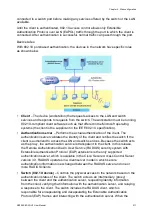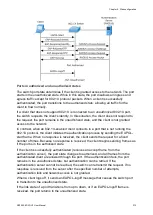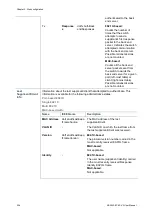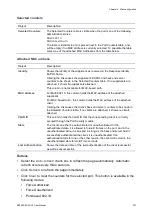
Chapter 4: Web configuration
218
NS3552-8P-2S-V2 User Manual
Port configuration
The table has one row for each port on the selected switch and a number of columns,
which are:
Object
Description
Port
The port number for which the configuration below applies.
Admin State
If NAS is globally enabled, this selection controls the port's authentication
mode. The following modes are available:
Force Authorized
In this mode, the switch sends one EAPOL success frame when the port link
comes up, and any client on the port will be permitted network access
without authentication.
Force Unauthorized
In this mode, the switch sends one EAPOL failure frame when the port link
comes up, and any client on the port will be disallowed network access.
Port-based 802.1X
In the 802.1X, the user is called the supplicant, the switch is the
authenticator, and the RADIUS server is the authentication server. The
authenticator acts as the man-in-the-middle, forwarding requests and
responses between the supplicant and the authentication server. Frames
sent between the supplicant and the switch are special 802.1X frames,
known as EAPOL (EAP Over LANs) frames. EAPOL frames encapsulate
EAP PDUs (RFC3748). Frames sent between the switch and the RADIUS
server are RADIUS packets. RADIUS packets also encapsulate EAP PDUs
together with other attributes like the switch's IP address, name, and the
supplicant's port number on the switch. EAP is very flexible in that it allows
for different authentication methods like MD5-Challenge, PEAP, and TLS.
The authenticator (switch) doesn't need to know which authentication
method the supplicant and the authentication server are using, or how many
information exchange frames are needed for a particular method. The switch
simply encapsulates the EAP part of the frame into the relevant type
(EAPOL or RADIUS) and forwards it.
When authentication is complete, the RADIUS server sends a special packet
containing a success or failure indication. Besides forwarding this decision to
the supplicant, the switch uses it to open up or block traffic on the switch port
connected to the supplicant.
Note
: Suppose two back end servers are enabled and that the server
timeout is configured to X seconds (using the AAA configuration page), and
suppose that the first server in the list is currently down (but not considered
dead). In this case, if the supplicant retransmits EAPOL Start frames at a
rate faster than X seconds, then it will never get authenticated, because the
switch will cancel on-going back end authentication server requests
whenever it receives a new EAPOL Start frame from the supplicant. And
since the server hasn't yet failed (because the X seconds haven't expired),
the same server will be contacted upon the next back end authentication
server request from the switch. This scenario will loop forever. Therefore, the
server timeout should be smaller than the supplicant's EAPOL Start frame
retransmission rate.
Single 802.1X
In port-based 802.1X authentication, the whole port is opened for network
traffic after a supplicant is successfully authenticated on a port. This allows
other clients connected to the port (through a hub, for example) to piggy-
back on the successfully authenticated client and get network access even
though they really aren't authenticated. To overcome this security breach,
Summary of Contents for NS3552-8P-2S-V2
Page 1: ...NS3552 8P 2S V2 User Manual P N 1073552 EN REV B ISS 25JAN19 ...
Page 41: ...Chapter 3 Switch management NS3552 8P 2S V2 User Manual 39 ...
Page 73: ...Chapter 4 Web configuration NS3552 8P 2S V2 User Manual 71 ...
Page 147: ...Chapter 4 Web configuration NS3552 8P 2S V2 User Manual 145 ...
Page 511: ......
















































